Next, lets add support for
- Data Structures
In the process of doing so, we will learn about
Heap Allocation
Run-time Tags
Creating Heap Data Structures
We have already support for two primitive data types
data Ty
= TNumber -- e.g. 0,1,2,3,...
| TBoolean -- e.g. true, falsewe could add several more of course, e.g.
CharDoubleorFloat
etc. (you should do it!)
However, for all of those, the same principle applies, more or less
- As long as the data fits into a single word (8-bytes)
Instead, lets learn how to make unbounded data structures
- Lists
- Trees
- …
which require us to put data on the heap
not just the stack that we’ve used so far.
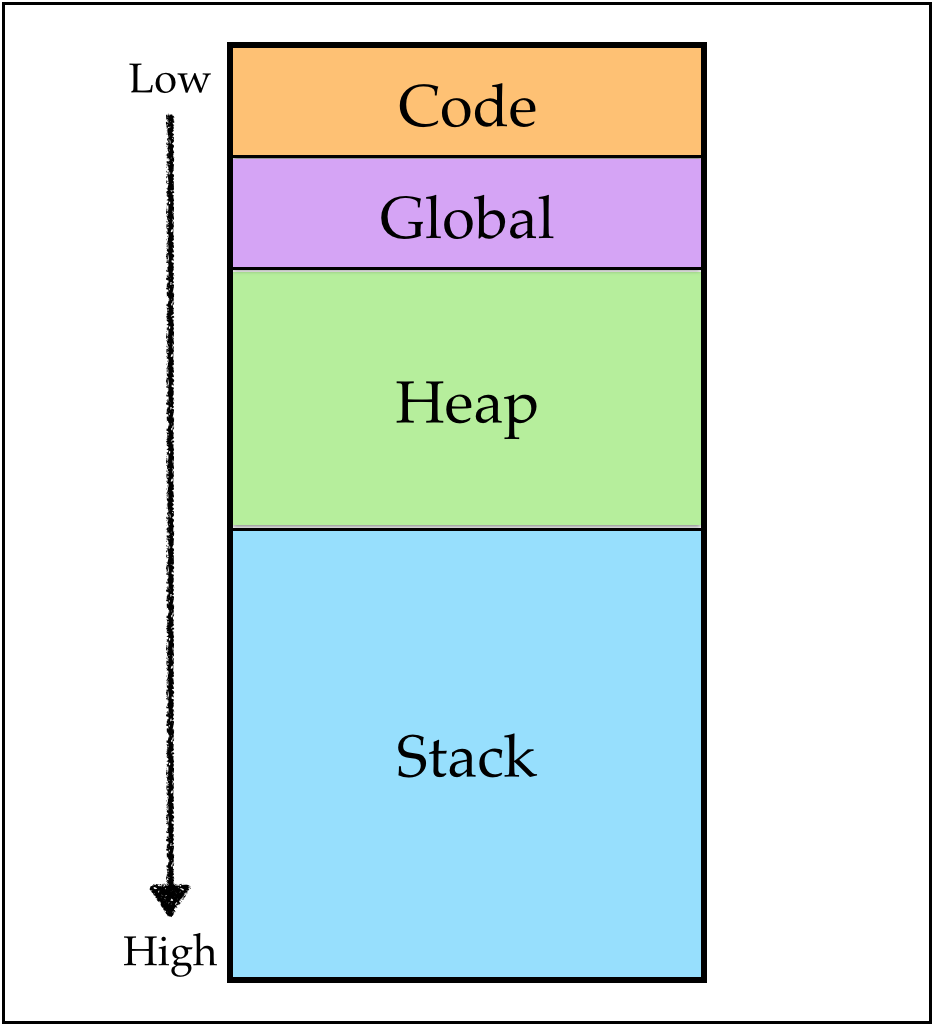
Pairs
While our goal is to get to lists and trees, the journey of a thousand miles begins with a single step…
So! we will begin with the humble pair.
Pairs: Semantics (Behavior)
First, lets ponder what exactly we’re trying to achieve.
We want to enrich our language with two new constructs:
Constructing pairs, with a new expression of the form
(e0, e1)wheree0ande1are expressions.Accessing pairs, with new expressions of the form
e[0]ande[1]which evaluate to the first and second element of the tupleerespectively.
For example,
let t = (2, 3) in
t[0] + t[1]should evaluate to 5.
Strategy
Next, lets informally develop a strategy for extending our language with pairs, implementing the above semantics. We need to work out strategies for:
- Representing pairs in the machine’s memory,
- Constructing pairs (i.e. implementing
(e0, e1)in assembly), - Accessing pairs (i.e. implementing
e[0]ande[1]in assembly).
1. Representation
Recall that we represent all values:
Numberlike0,1,2…Booleanliketrue,false
as a single word either
- 8 bytes on the stack, or
- a single register
rax,rcxetc.
EXERCISE
What kinds of problems do you think might arise if we represent a pair (2, 3) on the stack as:
| |
-------
| 3 |
-------
| 2 |
-------
| ... |
-------
QUIZ
How many words would we need to store the tuple
(3, (4, 5))1word2words3words4words5words
Pointers
Every problem in computing can be solved by adding a level of indirection.
We will represent a pair by a pointer to a block of two adjacent words of memory.
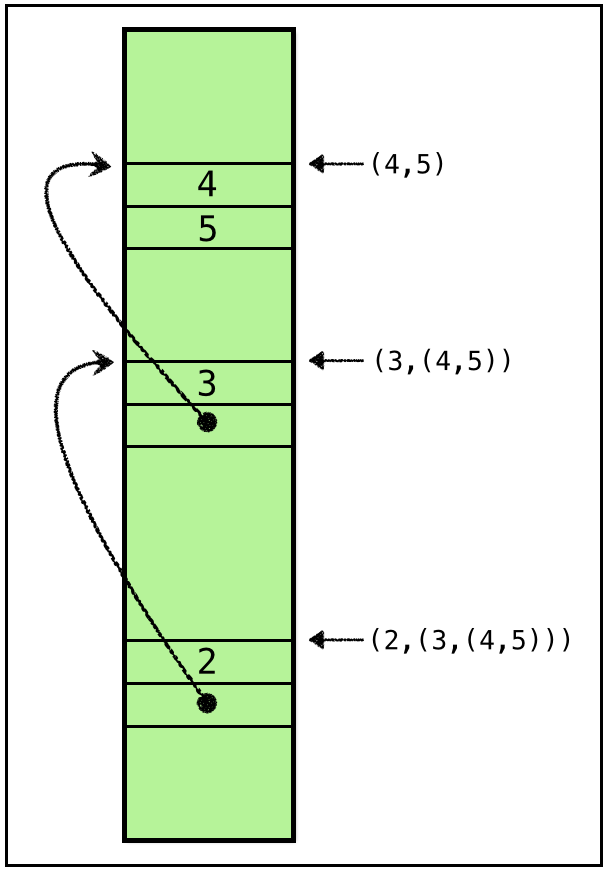
The above shows how the pair (2, (3, (4, 5))) and its sub-pairs can be stored in the heap using pointers.
(4, 5) is stored by adjacent words storing
4and5
(3, (4, 5)) is stored by adjacent words storing
3and- a pointer to a heap location storing
(4, 5)
(2, (3, (4, 5))) is stored by adjacent words storing
2and- a pointer to a heap location storing
(3, (4, 5)).
A Problem: Numbers vs. Pointers?
How will we tell the difference between numbers and pointers?
That is, how can we tell the difference between
- the number 5 and
- a pointer to a block of memory (with address
5)?
Each of the above corresponds to a different tuple
(4, 5)or(4, (...)).
so its pretty crucial that we have a way of knowing which value it is.
Tagging Pointers
As you might have guessed, we can extend our tagging mechanism to account for pointers.
| Type | LSB |
|---|---|
number |
xx0 |
boolean |
111 |
pointer |
001 |
That is, for
numberthe last bit will be0(as before),booleanthe last 3 bits will be111(as before), andpointerthe last 3 bits will be001.
(We have 3-bits worth for tags, so have wiggle room for other primitive types.)
Address Alignment
As we have a 3 bit tag
- leaving 64 - 3 = 61 bits for the actual address
So actual addresses, written in binary, omitting trailing zeros, are of the form
| Binary | Decimal |
|---|---|
0b00000000 |
0 |
0b00001000 |
8 |
0b00010000 |
16 |
0b00011000 |
24 |
0b00100000 |
32 |
| … |
That is, the addresses are 8-byte aligned.
Which is great because at each address, we have a pair, i.e. a 2-word = 16-byte block, so the next allocated address will also fall on an 8-byte boundary.
- But … what if we had 3-tuples? or 5-tuples? …
2. Construction
Next, lets look at how to implement pair construction that is, generate the assembly for expressions like:
(e1, e2)To construct a pair (e1, e2) we
- Allocate a new 2-word block, and getting the starting address at
rax, - Copy the value of
e1(resp.e2) into[rax](resp.[rax + 8]). - Tag the last bit of
raxwith1.
The resulting eax is the value of the pair
- The last step ensures that the value carries the proper tag.
ANF will ensure that e1 and e2 are immediate expressions
- will make the second step above straightforward.
EXERCISE How will we do ANF conversion for (e1, e2)?
Allocating Addresses
Lets use a global register r15 to maintain the address of the next free block on the heap.
Every time we need a new block, we will:
1. Copy the current r15 into rax
- Set the last bit to
1to ensure proper tagging. raxwill be used to fill in the values
2. Increment the value of r15 by 16
- Thus allocating 8 bytes (= 2 words) at the address in
rax
Note that addresses stay 8-byte aligned (last 3 bits = 0) if we
- Start our blocks at an 8-byte boundary, and
- Allocate 16 bytes at a time,
NOTE: Your assignment will have blocks of varying sizes
- You will have to maintain the 8-byte alignment by padding
Example: Allocation
In the figure below, we have
- a source program on the left,
- the ANF equivalent next to it.
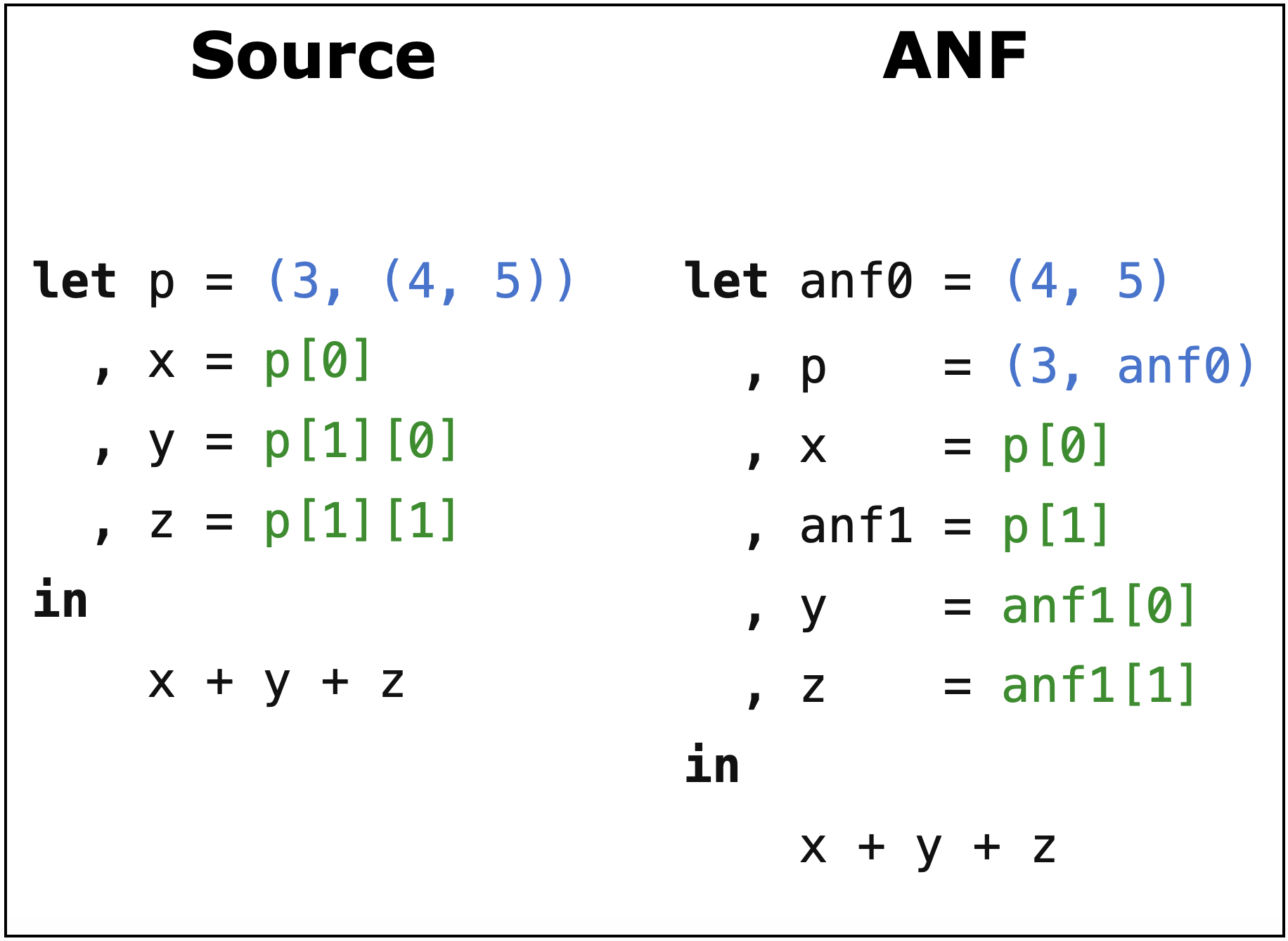
The figure below shows the how the heap and r15 evolve at points 1, 2 and 3:
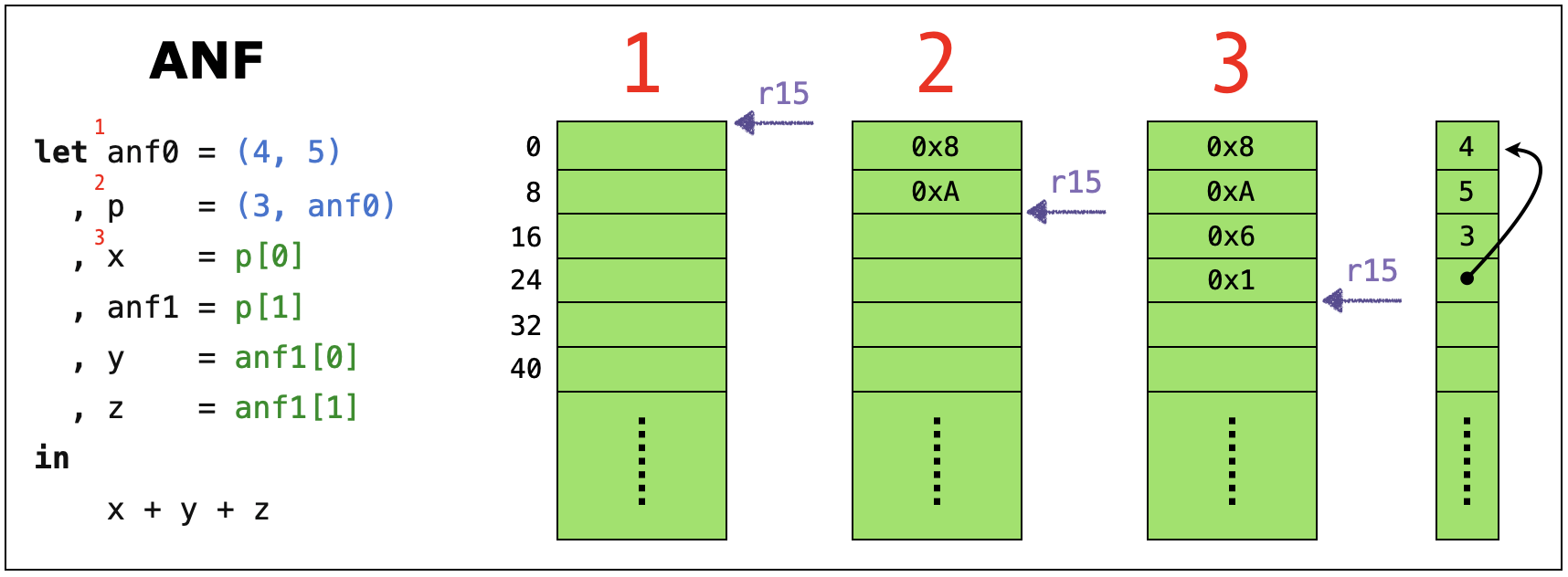
QUIZ
In the ANF version, p is the second (local) variable stored in the stack frame. What value gets moved into the second stack slot when evaluating the above program?
0x3(3, (4, 5))0x110x90x10
3. Accessing
Finally, to access the elements of a pair
Lets compile e[0] to get the first or e[1] to get the second element
- Check that immediate value
eis a pointer - Load
eintorcx - Remove the tag bit from
rcx - Copy the value in
[rcx](resp.[rcx + 8]) intorcx.
Example: Access
Here is a snapshot of the heap after the pair(s) are allocated.
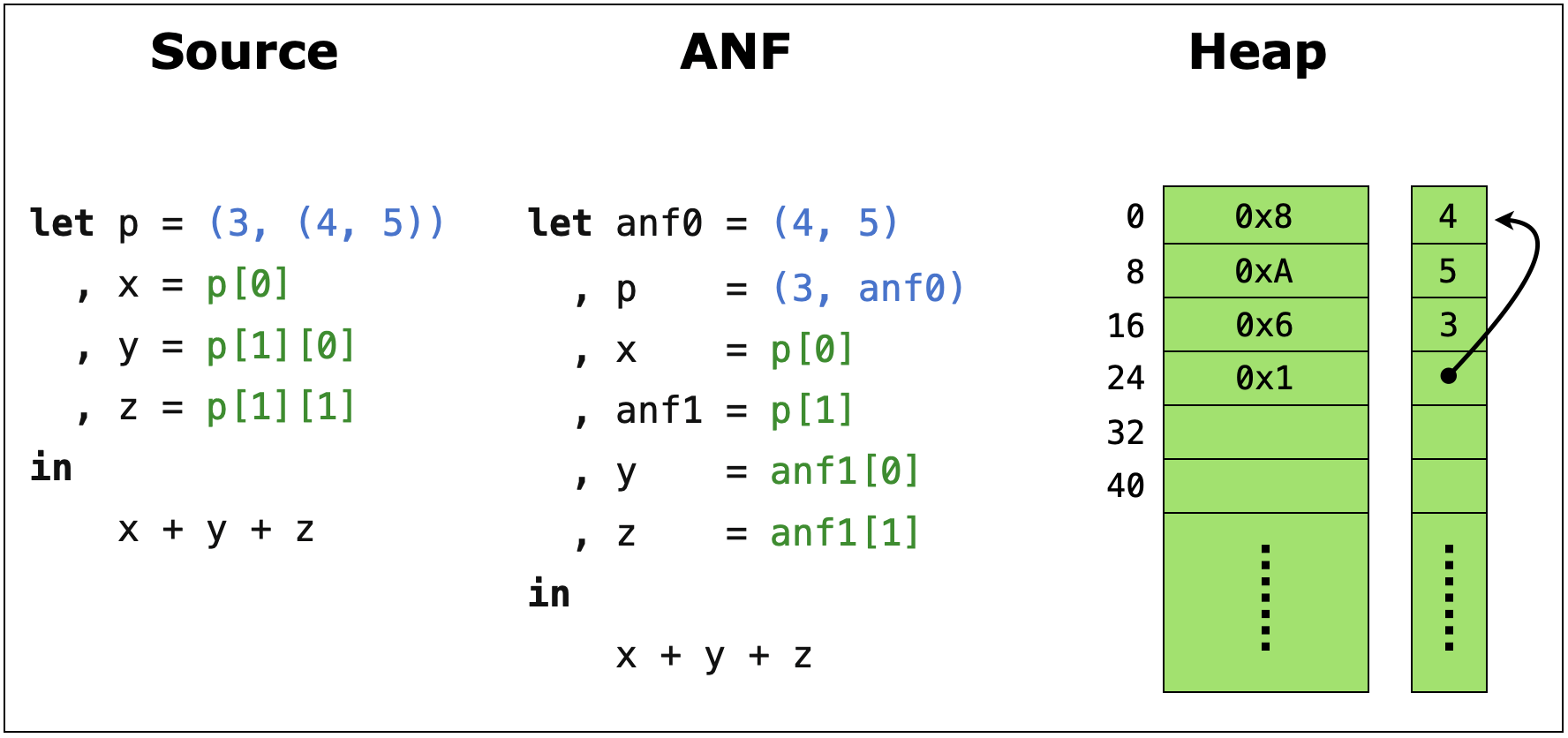
Lets work out how the values corresponding to x, y and z in the example above get stored on the stack frame in the course of evaluation.
| Variable | Hex Value | Value |
|---|---|---|
anf0 |
0x001 |
ptr 0 |
p |
0x011 |
ptr 16 |
x |
0x006 |
num 3 |
anf1 |
0x001 |
ptr 0 |
y |
0x008 |
num 4 |
z |
0x00A |
num 5 |
anf2 |
0x00E |
num 7 |
| result | 0x018 |
num 12 |
Plan
Pretty pictures are well and good, time to build stuff!
As usual, lets continue with our recipe:
- Run-time
- Types
- Transforms
We’ve already built up intuition of the strategy for implementing tuples.
Next, lets look at how to implement each of the above.
Run-Time
We need to extend the run-time (c-bits/main.c) in two ways.
Allocate a chunk of space on the heap and pass in start address to
our_code.Print pairs properly.
Allocation
The first step is quite easy we can use calloc as follows:
int main(int argc, char** argv) {
int* HEAP = calloc(HEAP_SIZE, sizeof (int));
long result = our_code_starts_here(HEAP);
print(result);
return 0;
}The above code,
- Allocates a big block of contiguous memory (starting at
HEAP), and - Passes this address in to
our_code.
Now, our_code needs to, at the beginning start with instructions that
- copy the parameter (in
rdi) into global pointer (r15) - and then bump it up at each allocation.
Printing
To print pairs, we must recursively traverse pointers
- until we hit
numberorboolean.
We can check if a value is a pair by looking at its last 3 bits:
int isPair(int p) {
return (p & 0x00000007) == 0x00000001;
}We can use the above test to recursively print (word)-values:
void print(long val) {
if(val & 0x1 == 0) { // val is a number
printf("%ld", val >> 1);
}
else if(val == CONST_TRUE) { // val is true
printf("true");
}
else if(val == CONST_FALSE) { // val is false
printf("false");
}
else if(val & 7 == 1) {
long* valp = (long *) (val - 1); // extract address
printf("(");
print(*valp); // print first element
printf(", ");
print(*(valp + 1)); // print second element
printf(")");
}
else {
printf("Unknown value: %#010x", val);
}
}
Types
Next, lets move into our compiler, and see how the core types need to be extended.
Source
We need to extend the source Expr with support for tuples
data Expr a
= ...
| Pair (Expr a) (Expr a) a -- ^ construct a pair
| GetItem (Expr a) Field a -- ^ access a pair's elementIn the above, Field is
data Field
= First -- ^ access first element of pair
| Second -- ^ access second element of pairNOTE: Your assignment will generalize pairs to n-ary tuples using
Tuple [Expr a]representing(e1,...,en)GetItem (Expr a) (Expr a)representinge1[e2]
Dynamic Types
Let us extend our dynamic types Ty see to include pairs:
data Ty = TNumber | TBoolean | TPair
Assembly
The assembly Instruction are changed minimally; we just need access to r15 which will hold the value of the next available memory block:
data Register
= ...
| R15
Transforms
Our code must take care of three things:
- Initialize
r15to allow heap allocation, - Construct pairs,
- Access pairs.
The latter two will be pointed out as cases in anf and compileEnv
TupleGetItem
Initialize
We need to initialize r15 with the start position of the heap
- passed in as
rdiby the run-time.
How shall we get a hold of this position?
To do so, our_code starts off with a prelude
prelude :: [Instruction]
prelude =
[ IMov (Reg R15) (Reg RDI) -- copy param (HEAP) off rdi
]Is that it?
QUIZ
Is r15 8-byte aligned?
- Yes
- No
Ensuring alignment
prelude :: [Instruction]
prelude =
[ IMov (Reg RAX) (HexConst 0xFFFFFFFF) -- setup regMask
, IShl (Reg RAX) (Const 32)
, IOr (Reg RAX) (HexConst 0xFFFFFFF8)
, IMov (Reg R15) (Reg RDI) -- copy param (HEAP) off rdi
, IAdd (Reg R15) (Const 8) -- add 8 and mask 3 bits to ensure
, IAnd (Reg R15) (Reg RAX) -- 8-byte aligned
]- Copy the value off the (parameter) stack, and
- Adjust the value to ensure the value is 8-byte aligned.
QUIZ
Why add 8 to r15? What would happen if we removed that operation?
r15would not be 8-byte aligned?r15would point into the stack?r15would not point into the heap?r15would not have enough space to write 2 bytes?
Construct
To construct a pair (v1, v2) we directly implement the above strategy:
compileEnv env (Tuple v1 v2)
= pairAlloc -- 1. allocate pair, resulting addr in `rax`
++ pairCopy First (immArg env v1) -- 2. copy first value into slots
++ pairCopy Second (immArg env v2) -- 3. copy second value into slot
++ setTag RAX TPair -- 3. set the tag-bits of `rax`Lets look at each step in turn.
Allocate
To allocate, we just copy the current pointer r15 and increment by 16 bytes,
- accounting for two 8-byte blocks for each element.
pairAlloc :: Asm
pairAlloc
= [ IMov (Reg RAX) (Reg R15) -- copy current "free address" `esi` into `eax`
, IAdd (Reg RAX) (Const 16) -- increment `esi` by 8
]Exercise How would you make this work for n-tuples?
Copy
We copy an Arg into a Field by
saving the
Arginto a helper registerrcx,copying
rcxinto the field’s slot on the heap.
pairCopy :: Field -> Arg -> Asm
pairCopy fld arg
= [ IMov (Reg RCX) arg
, IMov (pairAddr fld) (Reg RCX)
]Recall, the field’s slot is either [rax] or [rax + 8] depending on whether the field is First or Second.
QUIZ
What shall we fill in for _1 and _2 ?
pairAddr :: Field -> Arg
pairAddr First = RegOffset ?1 RAX
pairAddr Second = RegOffset ?2 RAXA. 0 and 1
B. 0 and -1
C. 1 and 2
D. -1 and -2
E. huh?
Tag
Finally, we set the tag bits of rax by using typeTag TPair which is defined
setTag :: Register -> Asm
setTag r = [ IAdd (Reg r) (HexConst 0x1) ]
Access
To access tuples, lets update compileEnv with the strategy above:
compileExpr env (GetItem e fld)
= assertType env e TPair -- 1. check that e is a (pair) pointer
++ [ IMov (Reg RAX) (immArg env e) ] -- 2. load pointer into eax
++ unsetTag RAX -- 3. remove tag bit to get address
++ [ IMov (Reg RAX) (pairAddr fld) ] -- 4. copy value from resp. slot to eaxwe remove the tag bits by doing the opposite of setTag namely:
unsetTag :: Register -> Asm
unsetTag r = ISub (Reg RAX) (HexConst 0x1)
N-ary Tuples
Thats it! Lets take our compiler out for a spin, by using it to write some interesting programs!
First, lets see how to generalize pairs to allow for
- triples
(e1,e2,e3) - quadruples
(e1,e2,e3,e4) - pentuples
(e1,e2,e3,e4,e5)
and so on.
We just need a library of functions in our new egg language to
- Construct such tuples, and
- Access their fields.
Constructing Tuples
We can write a small set of functions to construct tuples (up to some given size):
def tup3(x1, x2, x3):
(x1, (x2, x3))
def tup4(x1, x2, x3, x4):
(x1, (x2, (x3, x4)))
def tup5(x1, x2, x3, x4, x5):
(x1, (x2, (x3, (x4, x5))))
Accessing Tuples
We can write a single function to access tuples of any size.
So the below code
let yuple = (10, (20, (30, (40, (50, false))))) in
get(yuple, 0) = 10
get(yuple, 1) = 20
get(yuple, 2) = 30
get(yuple, 3) = 40
get(yuple, 4) = 50
def tup3(x1, x2, x3):
(x1, (x2, x3))
def tup5(x1, x2, x3, x4, x5):
(x1, (x2, (x3, (x4, x5))))
let t = tup5(1, 2, 3, 4, 5) in
, x0 = print(get(t, 0))
, x1 = print(get(t, 1))
, x2 = print(get(t, 2))
, x3 = print(get(t, 3))
, x4 = print(get(t, 4))
in
99should print out:
0
1
2
3
4
99How shall we write it?
def get(t, i):
TODO-IN-CLASS
QUIZ
Using the above “library” we can write code like:
let quad = tup4(1, 2, 3, 4) in
get(quad, 0) + get(quad, 1) + get(quad, 2) + get(quad, 3)What will be the result of compiling the above?
- Compile error
- Segmentation fault
- Other run-time error
410
QUIZ
Using the above “library” we can write code like:
def get(t, i):
if i == 0:
t[0]
else:
get(t[1],i-1)
def tup3(x1, x2, x3):
(x1, (x2, (x3, false)))
let quad = tup3(1, 2, 3) in
get(quad, 0) + get(quad, 1) + get(quad, 2) + get(quad, 3)What will be the result of compiling the above?
- Compile error
- Segmentation fault
- Other run-time error
410
Lists
Once we have pairs, we can start encoding unbounded lists.
To build a list, we need two constructor functions:
def empty():
false
def cons(h, t):
(h, t)
``
We can now encode lists as:
```python
cons(1, cons(2, cons(3, cons(4, empty()))))Access
To access a list, we need to know
- Whether the list
isEmpty, and - A way to access the
headand thetailof a non-empty list.
def isEmpty(l):
l == empty()
def head(l):
l[0]
def tail(l):
l[1]
Examples
We can now write various functions that build and operate on lists, for example, a function to generate the list of numbers between i and j
def range(i, j):
if (i < j):
cons(i, range(i+1, j))
else:
empty()
range(1, 5)which should produce the result
(1,(2,(3,(4,false))))
and a function to sum up the elements of a list:
def sum(xs):
if (isEmpty(xs)):
0
else:
head(xs) + sum(tail(xs))
sum(range(1, 5))which should produce the result 10.
Recap
We have a pretty serious language now, with:
- Data Structures
which are implemented using
- Heap Allocation
- Run-time Tags
which required a bunch of small but subtle changes in the
- runtime and compiler
In your assignment, you will add native support for n-ary tuples, letting the programmer write code like:
(e1, e2, e3, ..., en) # constructing tuples of arbitrary arity
e1[e2] # allowing expressions to be used as fieldsNext, we’ll see how to
use the “tuple” mechanism to implement higher-order functions and
reclaim unused memory via garbage collection.
